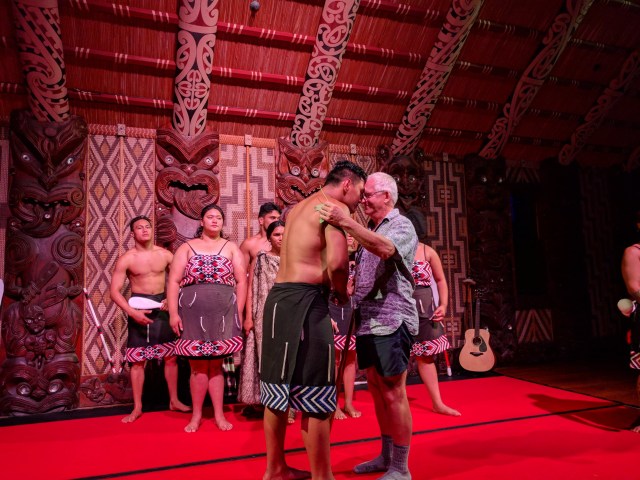
Mike and Marsha posing with the young men and women who performed the Maori cultural experience at the Waitangi Treat Grounds.
Especially on the North Island, you are always just one step from the indigenous Maori culture. In recent years, it has had a resurgence: it is one of the recognized languages (along with English and New Zealand Sign Language), there are immersion schools where parents must also learn Maori, there is a movement to hold the pakeha (white, British colonizers) to the Maori version of the founding 1840 Treaty of Waitangi. And as we traveled through Northland recently, marae (meeting houses) were very present, as with this example from the Waitangi Treaty Grounds with its intricate and beautiful wood carvings.

In the past few weeks, Mike and I have had two experiences of haka – the Maori ceremonial dances. Both were cultural performances, rather than hakas for particular events, but even so, they have left an impression.
The first haka was at the Waitangi Treaty Grounds in Paihia – the site where in 1840 representatives from Britain and Maori chiefs gathered to sign the first treaty between the Maori and a western power. The Waitangi Treaty Grounds gives both sides of the story, British and Maori, as well as a well-done museum that gives a sense of the changing relationships between Maori and western, or pakeha, people over the last 175 years.
On the Treaty Grounds the cultural performance, which includes the haka, is performed in the Marae. While the performance is clearly rehearsed, they begin by seriously re-enacting a part of the traditional welcoming ceremony that is part of Maori culture. This includes a fierce challenge by the young men, the placing on the ground of a token of peace, the acceptance of the peace token by the visiting chief, and a series of welcome speeches between the chiefs once inside the marae, which ends in the traditional hongi greeting, where two people touch noses and foreheads. Of course, the tourist group had no “chief” so the performers chose one: Mike!



Mike gave an impromptu speech of welcome that gave greetings from many lands and gave thanks for the efforts of the Maori and others to live in peace. I (Marsha) found it quite moving.
We then were given a 30-minute presentation of the fierce haka (posture chant) done in invoking your ancestors in preparation for fighting, the stick games played by children to develop hand-eye coordination, traditional songs accompanied by guitar, and the women showing their dexterity with the “poi” — two balls on string twirled about in different patterns.
Our second experience of haka was during Auckland Anniversary Weekend (Jan. 27-28). This regional holiday celebrates the creation of the Auckland Province in 1876. Although traditionally a day for sailing regattas, nowadays there is a huge street fair down at the harbour as well, which included a stage for Maori performances. We chanced upon one of the local school “kapa haka” groups performing songs and dances. Here’s a video clip that captures the energy both masculine and feminine. It is about 4 minutes long and shows the singing, the poi twirling, and (near the end) the fierce haka posturing. Only men put our their tongues; the women frown at the mouth and show the whites of their eyes.
We still hope to have an opportunity to experience Maori culture as a lived experience rather than a performance, but we are delighted that we have at least gotten a taste of the power, grace, beauty, and spirit that goes into these traditions.



